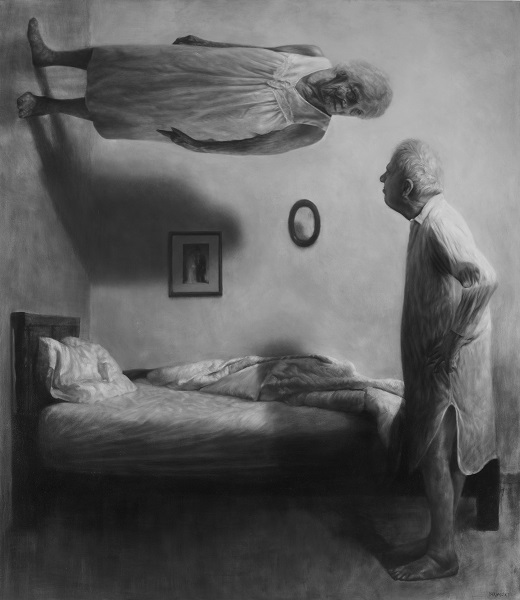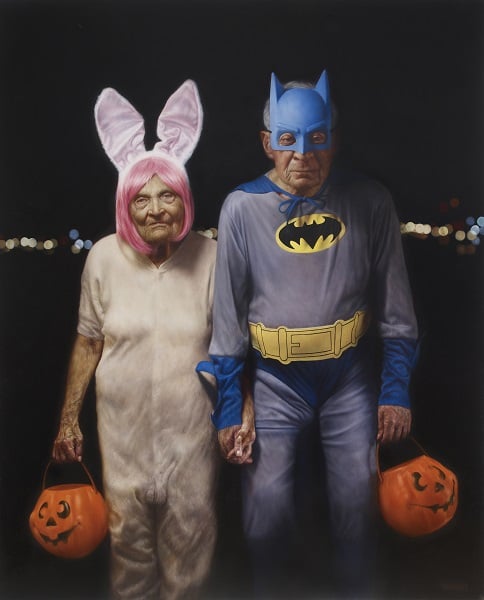Galleries
Interview with Artist Jason Bard Yarmosky
Let’s take a look at some of the top lots from Poly Auction Hong Kong.

Let’s take a look at some of the top lots from Poly Auction Hong Kong.

Elizabeth Pierce and Ope Omojola

Artist Jason Bard Yarmosky (American, b.1987) is a graduate of the School of Visual Arts, best known for his series of paintings, Elder Kinder. These works juxtapose youth with old age, and explore the social connotations of aging. artnet’s Elizabeth Pierce spoke to Jason in his studio about his work and his inspirations.
Elizabeth Pierce: Can you tell us a bit about working with Bertrand Delacroix Gallery?
Jason Bard Yarmosky: We started working together this past August. I love the gallery, and I’m so excited to have a show there and to be working with them. They’re very supportive.
EP: What should we know about your upcoming show, Dream of the Soft Look?
JBY: The first two solo shows that I did focused on my grandparents. I dressed them up in costumes and painted them in color. I wanted to bring out the inner, youthful aspect that we all have as we get older. But this show is a little bit different–it throws in another element: it’s not just about the physical aspect of aging, but about the psychological aspect as well. I did a podcast with my grandfather shortly after my last exhibition, and at one point, he mentioned how my great-grandfather said to him once that when he looked in the mirror, he felt the same way he felt when he was 18. That really stuck out to me.
I also made a video, shot in black and white, with Chopin’s Nocturne playing in the background, which follows my grandfather as he wakes up in the morning and does his whole painstaking routine–showering, shaving, etc. Then there are these moments where he’s having flashbacks, and they’re represented by 8mm footage that he shot in the 1950s of my grandma and my mom–and that’s in color. So it all relates to these paintings that I’ve been doing with them dressed up.
There are 18 paintings in the show. Most of them are in black and white. In one of the back rooms at the gallery, we’ll have the video playing, but in the front two windows, we want to have just two segments of that video playing. One will be a shot of my grandfather just looking at himself in the mirror. We just see his face, so we know he’s looking, but we’re not sure what he’s looking at. It makes me think of a portrait; it could be a painting, but then you see his head move suddenly. Next to it will be the 8mm footage of my mom as a kid, dancing ballet, and that’s in color. Those two videos represent the whole concept of the show–and when you walk in, you see all the paintings. So you get the past, the youthful, inner self, and then the present.

Jason Bard Yarmosky, Sleep Walking, 2013, oil on canvas, Bertrand Delacroix Gallery, New York, NY
EP: This is your first time working with video/film. Did you feel a difference between the process of making paintings and making videos? How did you feel you could communicate something different with using a different medium?
JBY: It’s the first time I did this, but it was really fun for me. It’s a different way to explore the same concept. I bought this camera, a 5D Mark 2, and learned how to use it watching YouTube tutorials. Just figuring it out as I went along was interesting.
EP: Do you think that since you have experimented with video, you’re going to use that more in the future?
JBY: Definitely. It’s exciting for me to have done this show using these concepts for video. But as my concepts evolve, my videos will evolve in terms of what I’m trying to get out of it. As I work on this, I get ideas for other things I would like to do, and I write them down so I can revisit them.
EP: How has your work and concept grown since your first solo show?
JBY: My work has grown technically and conceptually. It was fun for me to do some of my older works, but that was a stepping stone for what I’m doing now with this show. The painting Trick or Treaters (2013), for example, embodies all the work that came before it. The idea of them dressed up is the same, but the fact that they’re trick or treating with these pumpkin baskets emphasizes that they’re doing this as a thing. There is an idea that you can approach life with the same exuberance and interest as you age–exploring, learning, etc.
The last two shows I did, I was working primarily with my grandparents, but I was also using them as stand-ins for a more universal concept. The difference with this show is that I’m focusing more on them on an intimate level.

Jason Bard Yarmosky, Trick or Treaters, 2013, oil on canvas, Bertrand Delacroix Gallery, New York, NY
EP: How did your grandparents respond when you first approached them about it?
JBY: Well, they always would support what I was doing, but the first painting I did with my grandfather, he looked at me like I was nuts. But now he’s a joker, and my grandma was just funny–they had never really done anything like it before. But as we went on, they were interested in the value it would have with people seeing it, and they became interested in what I was trying to get out of it.
It’s so interesting to see how people react. There are usually very positive reactions, but we attach our own meaning to what we look at, so I think that as we get older, if we’re having a hard time with our own aging and how we view life, we’re going to see something like these paintings and feel uncomfortable. But regardless of what you end up feeling, successful art for me is able to evoke some type of emotion from the viewer, to get you to think, whether you like it or not. If it made you think, it did its job.
So working with my grandparents for these past three years, especially on this show, has been great for our relationship. The idea is that in our society, we don’t celebrate aging the way we do youth. The Cindy Sherman (American, b.1954) retrospective at the MoMA, with the big society portraits, was her way of showing society women trying to compete with a status- and youth-obsessed culture. The women depicted in her photographs have undergone cosmetic surgeries, but in the end, it’s kind of freakishly scary. But there’s also some element of humor in it. When I went to the exhibition, I saw some people laughing, some cringing.
What I’m trying to do doesn’t involve makeup. I paint every wrinkle, but she still looks beautiful. The way she is portrayed, you can look into her eyes, past what’s on the outside. There’s a Madeleine L’Engle quote I like to use: “You never lose all the ages you’ve been.”
I’ve always admired the way my grandparents look at life, even as their bodies have changed physically. This project has been great for all three of us in that sense.

Jason Bard Yarmosky, Madame X, 2013, oil on canvas, Bertrand Delacroix Gallery, New York, NY
EP: How do you feel about your own aging?
JBY: I’m okay with whatever it is. We shouldn’t limit ourselves to just one idea of beauty, we should accept it all. I have a great time with my grandparents, and I learn so much from them. They’ve already lived the life we’re going through right now.
Nobody should want to be young forever. You should want to enjoy all of life.
Jason Bard Yarmosky
Dream of the Soft Look
October 1–October 31, 2013
Bertrand Delacroix Gallery
535 West 25th Street
New York, NY 10001, USA